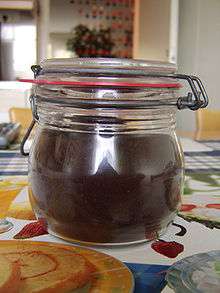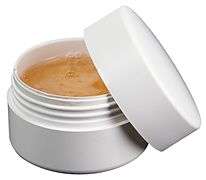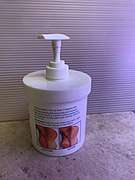Jar

A jar is a rigid, cylindrical or slightly conical container, typically made of glass, ceramic, or plastic, with a wide mouth or opening that can be closed with a lid, screw cap, lug cap, cork stopper, roll-on cap, crimp-on cap, press-on cap, plastic shrink, heat sealed lidding film, an inner seal, a Tamper-evident band, or other suitable means.
Jars are used to hold foods or other solids too large to be removed from or cosmetics, medications, and chemicals too viscous to be poured through a bottle's neck. [1] Glass jars—among which the most popular is the mason jar—can be used for storing and preserving items as diverse as jam, pickled gherkin, other pickles, marmalade, sun-dried tomatoes, olives, jalapeño peppers, chutneys, pickled eggs, honey, and many others.
Jars are sterilised by putting them in a pressure cooker with boiling water or an oven for a number of minutes. Glass jars are considered microwavable.[2]
Some regions[In what country?] have a legally mandated deposit refundable upon return of the jar to its retailer, after which the jar is recycled according to the SPI recycling code for the material.[3]
Gallery
 Preserved food in Mason jars
Preserved food in Mason jars Reusable jam jar with flip-top or bail closure
Reusable jam jar with flip-top or bail closure Jar made of PLA-blend bio-flex, a bioplastic
Jar made of PLA-blend bio-flex, a bioplastic Candy jar
Candy jar- Peanut butter
 Six types of "earthenware jar" in Spain
Six types of "earthenware jar" in Spain Brown-glazed jar with design of three fish. Yuan Dynasty.
Brown-glazed jar with design of three fish. Yuan Dynasty. PP jar of skin cream with pump dispenser
PP jar of skin cream with pump dispenser
See also
References
- ↑ Yam, K. L., "Encyclopedia of Packaging Technology", John Wiley & Sons, 2009, ISBN 978-0-470-08704-6
- ↑ Ahvenainen; Heiniö, R.-L. (1993). "Factors affecting the suitability of glass jars for heating in microwave ovens. Comparison with plastic jars and paper board tubs". Packaging Technology and Science. 6 (1): 43–52. doi:10.1002/pts.2770060108. Retrieved 2 Oct 2013.
- ↑ Soroka, W, "Fundamentals of Packaging Technology", IoPP, 2002, ISBN 1-930268-25-4
External links
| Look up jar in Wiktionary, the free dictionary. |

